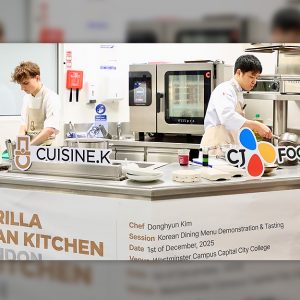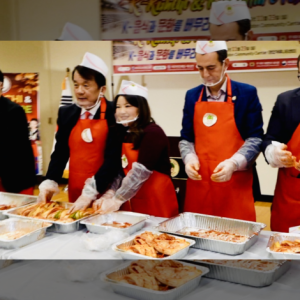[CJ Heritage] is a monthly column highlighting the evolution of CJ’s heritage and the best, the first, and the most unique corporate moments alongside modern Korean history

There are a countless number of ingredients that create flavor. Among these, sugar is one ingredient that we cannot live without. “Even the most ordinary sugar is such a remarkable spice,” Harold McGee quoted, an American author who writes about the chemistry of food and cooking. According to his statement, sugar is not only an ingredient that generates sweetness, but also an ingredient with versatility and a delicate taste.
So, when was sugar first produced in Korea?
Let’s find out the story of the first ever domestic sugar production through CJ’s narrative.
The Day that Snowed White Hope
On November 5, 1953, the historic day of Korea’s first ever sugar production, CheilJedang’s Busan factory was surrounded by tension. The workers shoveled the non-centrifugal cane sugar into the inlet. As the founder of CheilJedang, Lee Byung-chull pressed the switch button of the machine that was capable of generating 25 tons of sugar a day, the non-centrifugal cane sugar disappeared into the gigantic machine with a whirring sound.
After a short period of time, white particles started to pour out! From the establishment of the company to the introduction of facilities, securing resources, constructing factories, and commissioning, it was finally the moment all the hard work paid off. The 6-month process of effort that was made to build Korea’s first ever modern sugar factory was definitely worth it.
Engage with the “Cheil” Spirit
On June 3, 1953, CheilJedang, Korea’s first sugar producer, was officially launched at Samsung C&T’s office building in Busan. Not only the name “CheilJedang” was easy to recognize, but it also had the meaning of “engage with the best spirit”. The word “Cheil” interprets as the best in Korean. CheilJedang was the first modern large-scale production facility constructed in Korea since independence. The firm represented Korea’s economy and contributed greatly to the prosperity of the nation, hence, contained the “can-do spirit” of the people.

The beginning of the construction was as if they were jumping into the deep end. The foundation was built with soil that was dug with shovels, pickaxes, and sputum. All the steel were secondhand, and the building materials were shabby. Despite the lack of materials and facilities, the employees were determined to build Korea’s first ever sugar factory, and all employees worked hard to increase the construction speed.
And finally, in October 1953, CheilJedang’s Busan factory was constructed 2 months earlier than expected. The factory was able to produce 25 tons of sugar per day, which was a large-scale factory with the latest facilities at that time.
Korea’s First Ever Domestic Sugar, The Hope of 6,300kg
When CheilJedang’s Busan factory was completed, it attracted a lot of attention. Since there were barely any factories at that time, the tall chimney of the factory was enough to give people aspiration and pride. People that walked by the factory stood in front of the building and stared at Korea’s first ever sugar factory, expressing their expectations.

However, producing Korea’s first ever domestic sugar wasn’t an easy task. It seemed so close, yet far to success. And finally on November 5, 1953, Korea’s first ever domestic produced sugar was released. 6,300 kg of sugar was made on the first day of production. Workers started to distribute sugar that had the name “CheilJedang” on it.
November 6 was designated as the company’s anniversary because of the great excitement of the first production. Later that day, the executives gazed at the sales check, thinking about the blood, sweat and tears they sacrificed to build the sugar production facility in Korea.
To 100% Domestic Sugar Production
In the early 1950s, sugar was an indispensable commodity in our lives. In fact, due to the lack of sugar supply and inflation at the time, imported sugar prices rose to 300 hwan per 600g.
However, following Lee’s intention, CheilJedang did not increase the price of sugar. Not only was CheilJedang’ sugar taste good, but it was also cheap, which resulted in a high number of order as he expected. Due to the excess demand of sugar, Lee decided to expand the production facilities in April 1954.

CheilJedang’s goal was to double its production capacity to 50 tons per day. As CheilJedang expanded its production facilities, imported sugar started to lose its market share. In 1953, the total consumption of sugar in Korea was 23,800 tons and it was heavily dependent on imports with the market share of 97.5%, which was almost 100%. After the rise of CheilJedang, the figure gradually decreased to 66.7% in 1954, 34.3% in 1955, and at long last domestic sugar production reached 100% of the market share in 1958.
CheilJedang, which was successful in producing sugar domestically by 100%, they continued to expand their business. Imported sugar was no longer a market competitor for CheilJedang. Rather, the newly established domestic sugar companies were a bigger threat.
A Life-or-Death War in the Domestic Sugar Market
Started in 1954, market competition wasn’t intense between the seven domestic sugar production firms. Even after the establishment of factories of competitors, they were not able to operate the facility due to technical issues and had a hard time securing non-centrifugal cane sugar. But soon, all competitors started production, and the scale exceeded to about 150,000 tons of sugar. This was 2.5 times more than the total sugar demand in Korea.

Entering 1957, commodity taxes on sugar has significantly increased. As the commodity tax, which was originally 20 hwan per 600g, increased more than triple the rate, which made the retail price for refined sugar also jump triple the price from 70 won to 205 won. The drastic increase in sugar price soon led to a decrease in demand. In 1957, consumption plunged by less than half compared to the past year. Due to the surplus in supply, competition became more intense as demand decreased.
The Sugar Civil War, Quality Over Price
CheilJedang focused on enhancing quality to win the fierce market competition. In June 1957, as well as expanding facilities, they established the industry’s first R&D facility. Researchers dedicated all the effort to produce better quality sugar while eliminating unnecessary barriers in the production stage.
On the other hand, competitors came out with a different strategy. Competitors focused on the pricing strategy, offering the market 20% cheaper sugar compared to CheilJedang’s product. CheilJedang’s sales revenue fell for the first time since its establishment. Although the difficult situation continued, CheilJedang did not bother, rather trying to deal with the market disruption.
In 1958, due to excessive facility expansion and dumping sales, competitors started going bankrupt one after another. The sugar civil war came to a close, and the sugar industry finally found stability.
Even though CheilJedang was the market leader in the industry, they still tried their best to improve its facilities. Their fourth facility expansion started in 1960, and this time the focus was not on increasing production, but on improving quality and productivity. After four expansions starting with the first construction in 1953, CheilJedang’s production capacity increased to 265 tons per day, boasting the largest scale among domestic sugar firms.











